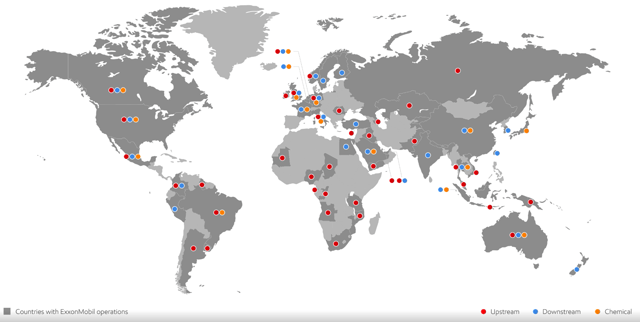Summary
- One day, rooftop and other powerful solar might generate sufficient electricity to power our homes, apartments, and businesses.
- One day, batteries will likely capture and store this energy at a level that reduces the need for transmission across long distances.
- Who knows? Maybe one day, small modular (nuclear) reactors and those using alternative coolants like liquid sodium will even win friends.
- Until that day, however, most electricity will be generated by utilities using natural gas (mostly in the developed world) and coal (elsewhere).
- That means today, and for some time to come, the best of the carbon-based producers, like XOM, will thrive.
- Looking for more stock ideas like this one? Get them exclusively at The Investor's Edge®. Get started today »
I was putting gas in my 61-year-old car at a filling station in my little town the other day when a tourist from California came out of the co-located shop and asked me, "What year is that car?"
"1959."
"Huh. What is it, some kind of MG or something?"
I smiled. "It's a Jaguar… XK 150."
"Hmmm. Well, it looks nice. Too bad it's a dinosaur."
OK, I've been to two county fairs, one war and a dog show that went ugly. I'm pretty even-tempered so I simply asked, "Why would you say that?"
"Well, in 10 years there won't be any gas stations. Just pollution-free electric battery charging stations for pollution-free cars like mine."
I allowed as how his car looked nice, too, then asked, "Where do you think the electricity that powers your EV -"
"It's not an EV, it's a Tesla!"
"Where do you think the electricity that powers that Tesla comes from?"
"That's a dumb question. It comes from the battery."
"And when the battery needs charging?"
"From a bigger battery, um, at the battery… places. Stations."
"And when they need to be recharged?"
"Who the hell cares? It's only important how… how green it is." He turned to respond to his wife who was driving the diesel pickup that was towing the gas-powered boat with the two gas-powered jet skis in the pickup bed with which they would soon be polluting my lake.
I never got to continue this illuminating conversation by pointing out that electricity, at least on a usable scale, was not produced by rubbing two balloons together. Nor is it a gift from the gods stored somewhere in Iowa or Nebraska or somewhere else that he might consider flyover country.
Electricity at the scale needed for transportation, lighting, heating etc. comes from either the photovoltaic process where light is turned into electricity, or from turbines that turn electric generators, effectively doing the same thing - excite and extract electrons into a moving flow. Those turbines might be powered by wind, water or biomass, but in most of the developed world, they are powered by the carbon fuel we call natural gas. (The developing world mostly uses coal, which is cheaper.)
The United States is the top producing country of natural gas in the world. Exxon Mobil (NYSE:XOM) is the biggest producer of natural gas in the United States.
The International Energy Agency, headquartered in Paris, is an intergovernmental organization established after the 1973 oil crisis. The IEA's initial charter was to advise member governments how to respond to disruptions in the supply of oil and to serve as a repository of statistics about the international oil markets. That charter was later broadened to include energy security, environmental protection (particularly climate change) and economic development.
Discussing global energy demand in November of 2019, the IEA concluded that global energy demand would continue rising at an increased pace. It specifically cited oil, considered by many to be at peak usage if not the old "peak oil" (then described as "Oh my God, the world is running out of oil,") as growing at least through 2030 and then plateauing as more vehicles, commercial and personal, switched to electric. (Enter natural gas…)
In the same report, the IEA noted that, as demand growth slows around 2030, the current rapidly depleting oil reserves will need to be replaced. The IEA predicts the increased cost of exploration should cause prices to rise from current levels to closer to $90 by 2030.
The IEA further predicts that the U.S.A. will account for 85% of the growth in production worldwide to 2030 between a renewed shale-oil boom and active exploration around the world. In fact, the organization expects that, within 5 years, U.S. production will reach 20.9 MM bpd, overtaking Saudi Arabia as the world's largest exporter of both crude and refined oil.
Exxon Mobil is the largest producer of oil in the US, with a production rate of 2.3mbbl per day.
Is Exxon Mobil "Over the Hill?"
XOM is regularly derided for not having been more aggressive in exploration when oil was more highly priced and for not squabbling to get a greater share of acreage in the Permian Basin and other popular onshore US fields. Were they stodgy, as many claim "over the hill" as a company, or crazy like a fox? Exxon instead chose to look for elephant fields with less competition abroad and wait to see if they could buy assets more cheaply at home.
That plan may yet come a cropper in Guyana, as a result of a contested election there, with the usual possibility of an incumbent unwilling to follow the will of the electorate. Exxon has a sizable investment there. Of course, it is only one of many major projects Exxon has on the books:
Source: Exxon Mobil website
Here is just a sampling of some of these opportunities…







